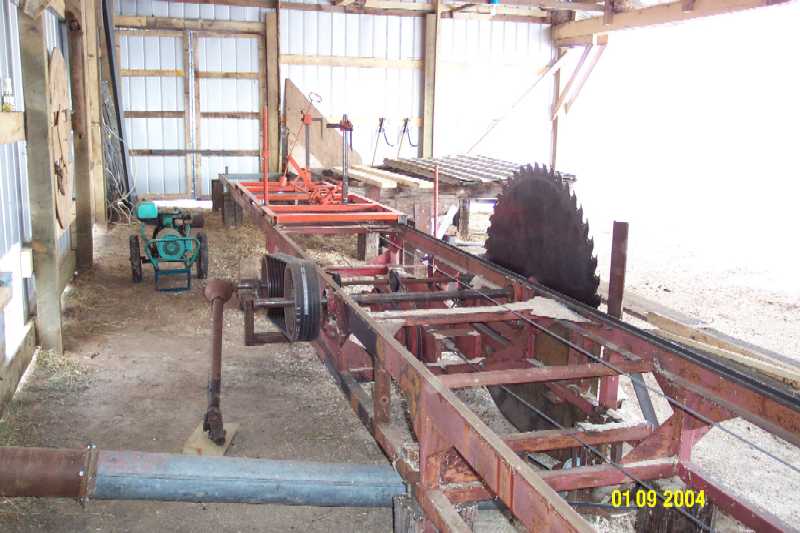back your tractor up and start sawing
Note, you better bring about 70hp of tractor or better else your in for a long slow day of sawing. Circle mills like the above fell out of favor for band mills due to kerf waste.
Actually, kerf waste was way down the list...it's just a side benefit.
The advantages of the small bandmills are:
1. Portable. You can move one in and be ready to saw in 10 minutes. You could move the old circle mill ( that one looks like a Belsaw M-14 ), but it would take you a day or more to set up to saw. I have mine set up in a shed, but sometimes I'll even move it to where the logs on my farm are located rather than move a whole pile of logs down to the mill area. I can roll the end down to the back end, and literally move the whole saw by hand on a good hard surface !
2. Low amount of horsepower required. As you noted, you'd need a 70hp tractor to do much with a circle mill....and then you have the tractor tied up the whole time, or you run a LARGE stationary power unit. My band mill uses an 18hp Briggs, and I have the tractor free to move lumber and slabs.
3. Smaller carriage. Look at how long that track is on the circle mill. Even the Belsaw M-14 ( which would saw 14' long max lumber ) is probably 35-40' long....because the carriage the log rides on has to start at the far end (clear of the blade ), pass by the blade, and clear the back end of the blade. That's 14.5 + blade width ( say 5' ) + 14.5' out the back end....34' minimum...most likely 36 or more.
My Woodmizer is 23' one end to the other.....and will saw a 21' log.....making 21' lumber.
4. Log diameter. On a circle mill, like above, you were limited to less than half the blade diameter. For example, that might be a 56" blade on that mill ( maybe less ). But you can only use about 20" of it (half the diameter, less some for the carriage height ). So you were limited to about a 20" log. My band mill will saw 34" ( and by shaving a bit with a chainsaw, I've sawed larger.)
5. Blades. Circle mills use (mostly) insert teeth. You have the blade 'blank', and buy a box of teeth that sorta roll into the gullet of the blade blank. But a big, thin hunk of steel used for the blank has a tendency to loose it's temper if you overheat it, or just over time. The blade has to be removed and 'hammered' to keep it's temper, or you just have a big FLOPPY piece of steel that won't cut worth anything. If you have to replace that blade, you're talking hundreds of bucks. The insert teeth were another nightmare. They had a tendency to "un-insert"....aahahahaaaa..... look at the roof over any old circle mill.....looks like you shot it with a machine gun where those teeth would come out, and fling in a 360 degree pattern....you're just seeing the ones that went thru the roof !
Band mills use a fairly cheap, (15-20 bucks) easy re-sharpened band (up to 3-5 times before it breaks). I can change a band in 3-4 minutes.
6. Better lumber. The old circle mills were notorious for "thick and thin" lumber. Between that big blade flopping around, and the length the carriage had to travel, it wasn't easy to cut accurate lumber. The whole reason the "quarter" scale came about (4/4, 5/4, 6/4, etc) was due to the low accuracy. The quarter scale has an extra 1/8" built into it.....so a 4/4 board is not 1", but 1 1/8". That gave the end user (like flooring or furniture companies ) a good shot at ending up with a finished 3/4" board.
Bandmills are extremely accurate for the most part. The lumber is consistent, and fairly smooth compared to circle mill lumber. I can cut on the inch scale ( which gives me a 15/16" board ) and usually still clean up to 3/4" after drying and planing. So not only do you save kerf ( 3/8" on a circle mill versus 1/16" on a band ), but you save not sending lumber to the pile of planer chips.





